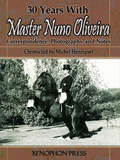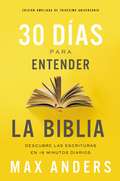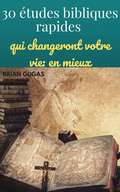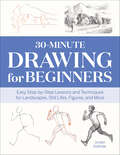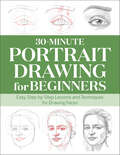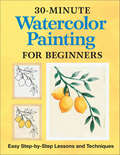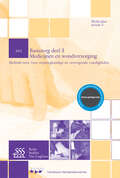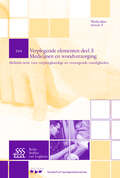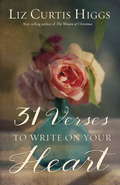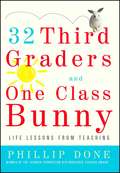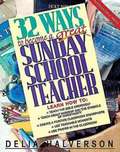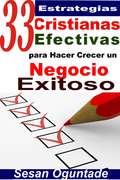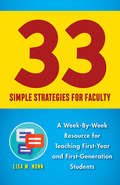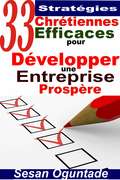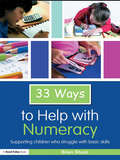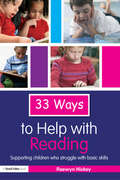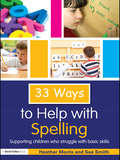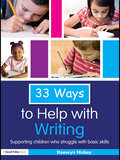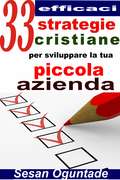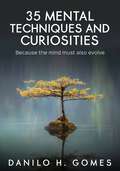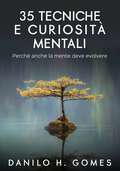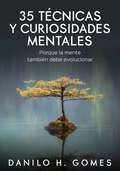- Table View
- List View
30 Years With Master Nuno Oliveira: Correspondence, Photographs, and Notes
by Michel HenriquetThis classical text, which knowledgeable horsemen have been anxiously awaiting for years, is finally available in English. Henriquet's personal record of correspondence provides a unique window into the private problem-solving dialogue between master and student. Now a master écuyer in his own right, Henriquet embellishes this new edition with 50 photographs from his personal collection. This first and only English edition includes many more photographs of Nuno Oliveira and his teacher than earlier editions. It has also been embellished with a glossary and a descriptive table of contents for the 71 chapters.
30 días para entender la Biblia, Edición ampliada de trigésimo aniversario: Descubre las Escrituras en 15 minutos diarios
by Max AndersSi alguna vez confundiste el arca del pacto con el arca de Noé, o Jericó con Jeroboam, el clásico de Max Anders, 30 días para entender la Biblia, es para ti. En solo quince minutos por día, aprenderás sobre las personas, los acontecimientos y las doctrinas de la fe cristiana más importantes, para obtener más provecho de la Palabra de Dios. Esta guía simple y fácil de usar ha sido recomendada por maestros bíblicos y pastores durante treinta años, y ahora está disponible en una edición ampliada del trigésimo aniversario, con los temas más solicitados de la edición original revisados y actualizados para los lectores de hoy. Las características incluyen:El “Arco de la Historia de la Biblia”, para ayudarte a visualizar los temas generales de las Escrituras.La “Historia de la Biblia”, que resume desde Génesis a Apocalipsis en solo unas pocas páginas.Las creencias centrales de la fe cristiana, basadas en las enseñanzas que han unido a los cristianos durante los últimos dos mil años.Un plan de trece semanas que proporciona a cada maestro todas las herramientas creativas y eficaces para enseñar la Biblia en treinta días.Contenido extra favorito de los fanáticos, que había sido eliminado anteriormente y ahora está restaurado de la edición original.
30 études bibliques rapides: qui changeront votre vie en mieux
by Brian GugasLa seule façon de vraiment connaître Dieu et de savoir ce qu'il attend de nous en tant qu'enfants est de lire et d'étudier la Bible, de prier, d'adorer et de servir ensemble avec d'autres chrétiens. C'est là que ce livre entre en jeu. Chacune des trente études bibliques suivantes couvre un sujet qui, à un degré ou à un autre, est pertinent pour la plupart des gens. Chacune des trente études contient des textes bibliques, un exemple biblique du sujet traité, un exemple plus moderne et des suggestions pour appliquer ce que vous avez lu à votre vie. La Bible est la Parole de Dieu. Laissez-la vous parler. Laissez-la changer votre vie... pour le mieux.
30-Minute Drawing for Beginners: Easy Step-by-Step Lessons and Techniques for Landscapes, Still Lifes, Figures, and More (30-Minute Drawing for Beginners)
by Jordan DeWildeUnlock your drawing potential with lessons you can do on your lunch breakNo drawing experience? No time for classes? No problem! 30-Minute Drawing for Beginners can teach you a new drawing technique in the time it takes to fold the laundry or grab a coffee. Broken into bite-sized lessons on how to draw, this entry-level drawing book for adults of all ages gives you a strong foundation in the fundamentals, like shading, perspective, composition, and more.Grow your drawing skills and confidence with:Easy-to-follow instructions—Build your abilities with illustrated, step-by-step directions designed to help you progress from sketching simple forms to detailed landscapes and self-portraits.Essential techniques—Learn the key elements you'll need to improve your drawing, such as shape, texture, and form, and then practice what you've learned with bonus challenges.Lessons you'll want to practice—With some exercises as short as 10 minutes, it's easy to fit lessons from 30-Minute Drawing for Beginners into even the busiest schedule.Start learning to draw in minutes with this fun and encouraging guide to drawing for beginners.
30-Minute Portrait Drawing for Beginners: Easy Step-by-Step Lessons and Techniques for Drawing Faces (30-Minute Drawing for Beginners)
by Portrait DrawingLearn to draw portraits with easy 30-minute lessonsDo you want to develop the skills to create detailed and expressive portraits? This book makes it easy! Each page guides you through short, at-home lessons on how to draw realistic faces. As you work your way through step-by-step instructions for everything from choosing supplies to outlining a face and sketching each feature, you'll start to transform basic lines into fully-formed portraits. No experience required—These exercises are designed for complete beginners, helping you learn the foundations of drawing in bite-size lessons. Quick and simple exercises—With activities that only take half an hour, it's easy to make time to draw on a coffee break, over lunch, or whenever your schedule allows. Grow your skills—Explore techniques that build on each other as you play with key elements like shadow, light, and texture. Spark your artistic side with 30-Minute Portrait Drawing for Beginners!
30-Minute Watercolor Painting for Beginners: Easy Step-by-Step Lessons and Techniques
by Rockridge PressLearn to create your own gorgeous watercolor artwork—in just 30 minutes at a time!Master watercolor basics while creating your own frame-worthy art following the fun and simple lessons in this watercolor book for adults. Beautifully presented instructions and illustrations show you the fundamentals of watercolor for beginners, so you can develop your skills in a series of projects, from a dramatic landscape to an abstract art piece. Best of all, each lesson is designed to take 30 minutes or less, so it's easy to make time for art and learning a new skill!No experience required—Learn how to choose and assemble your supplies, and how to paint using color theory and composition techniques.Practice watercolor techniques—Mix colors and try various brushstrokes and washes over the course of 5 different lessons.Paint! —Produce your own artwork with 15 painting projects with step-by-step instructions on how to watercolor flowers, animals, and more.Start painting today with 30-Minute Watercolor Painting for Beginners!
301 Essays & Letters
by BPI India Pvt LtdCollection of Essays, Personal Letters, Formal Letters, Business Letters, Creative writing, Precise Writing, e-mail and Paragraph writing.
302 Basiszorg deel 3 Medicijnen en wondverzorging: Basiszorg: deel 3 (niveau 3) (Skillslab-serie)
by Judith AlkemaDit cahier vormt een onderdeel van de cahiers rondom de basiszorg voor verzorgenden. In dit werkcahier zijn de volgende onderwerpen opgenomen: het toedienen van medicijnen en wondverzorging.
304 Verplegende elementen: Werkcahier Kwalificatieniveau 3 (Skillslab-serie)
by Judith Alkema Marion VroonWerkcahier inclusief de cd–rom's Medicijnen en WondverzorgingDit cahier vormt een onderdeel van de cahiers voor de deelkwalificatie 304: verplegende elementen.
31 Verses to Write on Your Heart
by Liz Curtis HiggsHere are the words of hope you're looking for when your faith needs a boost or a friend needs encouragement. Chosen by more than a thousand women as their favorite verses in the Bible, each one is worth learning, worth sharing, worth remembering, You'll find verses you already know and love: "I can do all this through him who gives me strength" (Philippians 4:13). Others may be less familiar but are no less powerful: "Fear of man will prove to be a snare, but whoever trusts in the Lord is kept safe" (Proverbs 29:25). All of them capture the truth of God's goodness, mercy, and love for His own. Best-selling author Liz Curtis Higgs invites you to experience--A deeper, richer understanding of thirty-one treasured verses. A fresh look at how these timeless truths can impact your life. A new passion for memorizing Scripture, verse by verse. Thirty-one creative ways to keep them in your heart forever. With a Study Guide included, 31 Verses to Write on Your Heart is a daily devotional and a small group Bible study, wrapped in a lovely gift book overflowing with joy!From the Hardcover edition.
32 Third Graders And One Class Bunny: Life Lessons From Teaching
by Phillip DoneA funny and intimate book about what really goes on at school.
32 Third Graders and One Class Bunny
by Phillip Done Ruth Lee MuiPhillip Done fixes staplers that won't staple, zippers that won't zip, and pokes pins in the caps of glue bottles that will not pour. He has sung "Happy Birthday" 657 times. A witness to the joys of discovery, Done inspires readers with the everyday adventures and milestones of his 32 third graders in this irresistible collection of bite-sized essays. From the nervous first day of school to the hectic Halloween parade to the disastrous spring musical, Done connects what happens in his classroom to the universal truths that touch us all. He reminds us of the delight of learning something for the first time and of the value of making a difference. 32 Third Graders and One Class Bunnyis for anyone who has ever taught children -- or been to third grade. It is a testament to the kids who uplift us -- and the teachers we will never forget. With just the right mix of humor and wisdom, Done reveals the enduring promise of elementary school as a powerful antidote to the cynicism of our times.
32 Ways to Become a Great Sunday School Teacher
by Delia HalversonA self-directed teacher training resource offering four courses of study for both experienced teachers and beginners. For many churches teacher training is a once-a year event, or even a budget casualty. 32 Ways to Become a Great Sunday School Teacher uses self-study sessions to help teachers design individualized programs that assist them in learning how to teach. New teachers will learn the basics of teaching (how faith develops; the ages and stages of learning); veterans will find ways to enrich their prayer lives and incorporate different teaching styles in a lesson. A sampler of topics: How to Study a Bible Passage; Multiple Intelligence Learning; Death, Illness, Other Crises; Using Questions in Teaching; The Gospels; Prayer in the Classroom; The Sacraments; Symbols of Christianity
33 Estrategias Cristianas Efectivas para Hacer Crecer un Negocio Exitoso: Principios cristianos y bíblicos para operar un pequeño negocio exitoso como una persona de fe
by Sesan Oguntade33 Estrategias Cristianas Efectivas para Hacer Crecer un Negocio Exitoso por Sesan Oguntade Principios cristianos y bíblicos para operar un pequeño negocio exitoso como una persona de fe Si a usted le gustaría tener algunos principios llenos de poder cristiano para manejar un negocio exitoso, entonces este libro es para usted. Realmente usted puede llevar su pequeño negocio al siguiente nivel con estos principios bíblicos de negocios comprobados y bien presentados. Como cristiano, recurro a la Biblia para que me provea estrategias viables para operar mi organización porque creo que todos los buenos principios de éxito están representados en la Biblia. No me sorprendió cuando empecé a ver estos principios de éxito empresarial en la Biblia. Comencé a tomar nota de ellos y también comencé a usarlos. He experimentado una gran satisfacción a partir del uso de estos principios. Tomé la decisión de poner estos principios en este libro en una manera sencilla y legible para que otras personas también puedan beneficiarse inmensamente de ellos. Género: RELIGIÓN / Vida Cristiana / Crecimiento Personal Género Secundario: RELIGIÓN / Educación Cristiana / Adulto Idioma: Español Palabras Clave: Evangélico, negocio, principios cristianos, éxito comercial, pequeño negocio, principios comerciales Número de palabras: 15250 Información de ventas: 1,809,145 Texto de muestra: ¿ESTÁ POR INICIAR UN NUEVO NEGOCIO? ORE POR PERSPICACIA ¿Ha visto alguna vez a un cazador buscando sus presas en el bosque? ¿Ha visto también a un aventurero buscando un tesoro? Van por sus presas con toda su atención y con todo lo que tienen. Esta debe ser la actitud de usted al orar pidiendo perspicacia al iniciar un nuevo negocio. Algunas personas no creen que sea necesario orar pidiendo perspicacia o entendimiento o discernimiento antes de iniciar un nuevo negocio. Usted debe realizar e
33 Estratégias Cristãs Eficazes para Crescer um Negócio de Sucesso: Princípios Bíblicos e Cristãos para gerir um pequeno negócio como Cristão
by Sesan OguntadeSe tu gostarias de ter alguns princípios Cristãos para gerir um negócio bem sucedido, então este livro é para ti. Tu podes na realidade levar o teu pequeno negócio a outro nível com estes provados, bem apresentados, princípios de negócio bíblicos. Como Cristão, eu vejo a bíblia para me providenciar com estratégias funcionais para gerir a minha organização, porque eu acredito que todo princípio de sucesso bom esteja representado na bíblia. Eu não fiquei surpreendido quando comecei a ver princípios de sucesso de negócio na bíblia. Eu comecei a tomar notas dos mesmo e comecei também a usa-los. Tomei a decisão de por estes princípios neste livro de froma simples e legível para que outros possam também beneficiar imenso deles.
33 Simple Strategies for Faculty: A Week-By-Week Resource for Teaching First-Year and First-Generation Students
by Lisa M. NunnMany students struggle with the transition from high school to university life. This is especially true of first-generation college students, who are often unfamiliar with the norms and expectations of academia. College professors usually want to help, but many feel overwhelmed by the prospect of making extra time in their already hectic schedules to meet with these struggling students. 33 Simple Strategies for Faculty is a guidebook filled with practical solutions to this problem. It gives college faculty concrete exercises and tools they can use both inside and outside of the classroom to effectively bolster the academic success and wellbeing of their students. To devise these strategies, educational sociologist Lisa M. Nunn talked with a variety of first-year college students, learning what they find baffling and frustrating about their classes, as well as what they love about their professors’ teaching. Combining student perspectives with the latest research on bridging the academic achievement gap, she shows how professors can make a difference by spending as little as fifteen minutes a week helping their students acculturate to college life. Whether you are a new faculty member or a tenured professor, you are sure to find 33 Simple Strategies for Faculty to be an invaluable resource.
33 Stratégies Chrétiennes Efficaces pour Développer une Entreprise Prospère
by Sesan OguntadePrincipes Chrétiens et bibliques pour développer une petite entreprise prospère en tant que Chrétien. Si vous souhaitez connaitre des principes Chrétiens pour développer une entreprise prospère, alors ce livre est pour vous. Vous pouvez vraiment faire passer votre petite entreprise à un autre niveau grâce à ces principes commerciaux bibliques éprouvés et bien présentés. En tant que Chrétien, je regarde vers la Bible pour obtenir des stratégies réalisables pour gérer le fonctionnement de mon organisation parce que je crois que tous les bons principes de réussite sont représentés dans la Bible. Je n'ai pas été surpris lorsque j'ai commencé à voir ces principes de réussite commerciale dans la Bible. J'ai commencé à en prendre note et j'ai également commencé à les utiliser. J'ai éprouvé une grande satisfaction a utilizer de ces principes. J'ai pris la décision de mettre ces principes dans ce livre sous une forme simple et lisible afin que d'autres personnes puissent également en bénéficier énormément.
33 Ways to Help with Numeracy: Supporting Children who Struggle with Basic Skills (Thirty Three Ways to Help with....)
by Brian SharpThirty Three Ways to Help with Numeracy equips teachers and teaching assistants with a wide range of practical resources to help children who are having difficulties learning the basic skills of numeracy. By providing a range of activities and games which engage children and encourage motivation in the classroom, the book provides ready-to-use exercises that don’t need lengthy forward preparation. Any materials needed are readily available in the classroom or are provided here to photocopy. The activities are designed using a range of different learning styles to: build learners’ confidence and self esteem develop reasoning and thinking about physical number situations encourage discussions explore numbers by doing The activities can be used with individual children, groups or the whole class. The introduction at the head of each activity describes precisely what it aims to teach the child, followed by clear, concise instructions on how to play each game. Teachers, SENCos and Teaching Assistants will welcome this helpful resource, which complements Thirty Three Ways to Help with Reading also available from Routledge.
33 Ways to Help with Reading: Supporting Children who Struggle with Basic Skills (Thirty Three Ways to Help with....)
by Raewyn HickeyThirty Three Ways to Help with Reading equips teachers and teaching assistants with a wide range of practical resources to help children who are having difficulties learning the basic skills of reading. By providing a range of activities and games which engage children and encourage motivation in the classroom, the book provides ready-to-use material that doesn’t need lengthy forward preparation. These practical and fun ideas incorporate a range of learning styles, using kinaesthetic and auditory techniques, which put the emphasis on ‘games’ rather than ‘work’. The activities are therefore ideal for use with children who do not benefit from a traditional approach to reading. The book works step-by-step through activities which cover the key stages in the process of learning to read: Learning letters Recalling frequently used words Hearing sounds in words Blending sounds Reading for meaning The ‘how to help’ approach of the book is ideal for teachers and teaching assistants wanting to give quality learning experiences for those children experiencing difficulties with reading. With all the resources needed for the games included, the book provides quick and easy to use ideas, which can be implemented instantly in the classroom. The Routledge ’33 ways…’ series of practical ‘how-to’ books is for teachers, teaching assistants and SENCOs who are in need of fresh ideas to teach pupils in their care who are struggling with basic skills. It provides them with the tools to make good provision for a range of children in their class, and are planned to be a resource from which they can extract ideas and materials without having to plough through chapters of theory and research. Raewyn Hickey is an experienced classroom teacher who has worked in both the Literacy Initiative for Teachers project in Westminster and as a consultant for the Primary Strategy.
33 Ways to Help with Spelling: Supporting Children who Struggle with Basic Skills (Thirty Three Ways to Help with....)
by Sue Smith Heather Morris33 Ways to Help with Spelling equips teachers and teaching assistants with a wide range of practical resources to help children who are having difficulties learning the basic skills of spelling. Offering a range of activities and games to engage children and encourage motivation in the classroom, this essential classroom companion provides ready-to-use material that doesn’t need lengthy forward preparation. Activities include auditory and visual mnemonics, phonetics and tactile tasks. These practical and fun ideas incorporate a variety of learning styles, using kinaesthetic and auditory techniques, that put the emphasis on ‘games’ rather than ‘work’. The activities are especially suitable for teaching assistants working with individuals or small groups. The book works step-by-step through practical activities which: keep children motivated and enjoying learning don't require extensive knowledge or experience from the adult are adult-led so children don't have the opportunity to repeat mistakes are grouped into different basic skills, so teachers can choose the activity best suited for the child’s needs have clear, concise and pedagogically sound reasons for the activity include extension activity where appropriate to challenge pupils. Aimed mainly at primary pupils, secondary teachers will also find this book invaluable to use with pupils who are falling behind. The series facilitates good inclusive provision and is a resource from which useful ideas and materials can be taken without having to plough through chapters of theory and research.
33 Ways to Help with Writing: Supporting Children who Struggle with Basic Skills (Thirty Three Ways to Help with....)
by Raewyn Hickey33 Ways to Help with Writing equips teachers and teaching assistants with a wide range of practical resources to help children who are having difficulties learning the basic skills of writing. Offering a range of activities and games to engage children and encourage motivation in the classroom, this essential classroom companion provides ready-to-use material that doesn’t need lengthy forward preparation. These practical and fun ideas incorporate a variety of learning styles, using kinaesthetic and auditory techniques, which put the emphasis on ‘games’ rather than ‘work’. The activities are especially suitable for teaching assistants working with individuals or small groups. 33 Ways to Help with Writing works step-by-step through practical activities which: keep children motivated and enjoying learning do not require extensive knowledge or experience from the adult are adult-led so children don't have the opportunity to repeat mistakes are grouped into different basic skills, so teachers can choose the activity best suited for the child’s needs have clear, concise and pedagogically sound reasons for the activity include extension activity where appropriate to challenge pupils.
33 efficaci strategie cristiane per sviluppare la tua piccola azienda
by Sesan Oguntade33 efficaci strategie cristiane per sviluppare la tua piccola azienda ti mostrerà semplici strategie per avviare e sviluppare la tua piccola azienda. Questi consigli Cristiani ti aiuteranno a far crescere la tua azienda passo dopo passo. Questo libro unisce in modo pratico i principi che vengono dalla parola di Dio e i metodi attuali che gli imprenditori possono usare per le loro piccole aziende per quanto concerne l'amministrazione e lo sviluppo. Oltre 33 suggerimenti semplici ed efficaci condivisi in questo libro ti aiuteranno ad avere successo nella tua vita e negli affari.
35 Mental Techniques (and Curiosities): Because the mind must also evolve
by Danilo H. GomesThey give us very little information about the power of our mind (unless you go through a psychology faculty, for example). There are no classes on "how to improve memory" or "how to increase the production of certain hormones" at school. We need to have access to the techniques that humanity discovered when it comes to the mind and its incredible powers, as studying them will lead us to transform our lifestyles. Get this work and venture out knowing a part of what your brain can do.
35 Tecniche (e Curiosità) Mentali: Perché anche la mente deve evolvere
by Danilo H. GomesIn tanti momenti della vita sentiamo il bisogno di conoscere qualche trucco che possa risolvere un problema. Ci fanno conoscere pochissime informazioni sul potere della mente. Nel corso della storia, molte tecniche furono scoperte riguardo alla mente umana che possono trasformare qualsiasi stilo di vita. 35 TECNICHE (E CURIOSITÀ) MENTALI offre diverse tecniche efficaci per soluzionare impasse quotidiani semplici e complessi, oltre a perfezionare certe capacità mentali. Metti in pratica queste tecniche e strategie mentali per migliorare le tue abilità e rendere più facile la tua vita quotidiana.
35 Técnicas (y Curiosidades) mentales: Porque la mente también debe evolucionar
by Danilo H. GomesExisten varios momentos en la vida en los que precisamos de un truco que nos pueda ayudar a resolver un problema. Se nos enseñó muy poco con relación al poder de la mente. A lo largo de la historia, se han descubierto muchas técnicas que pueden transformar cualquier estilo de vida. '35 Técnicas (y Curiosidades) mentales' le enseña varias técnicas efectivas para resolver problemas cotidianos, simples o complejos. Ponga en práctica diversas técnicas y estrategias mentales para mejorar sus habilidades y facilitar su vida diaria.
